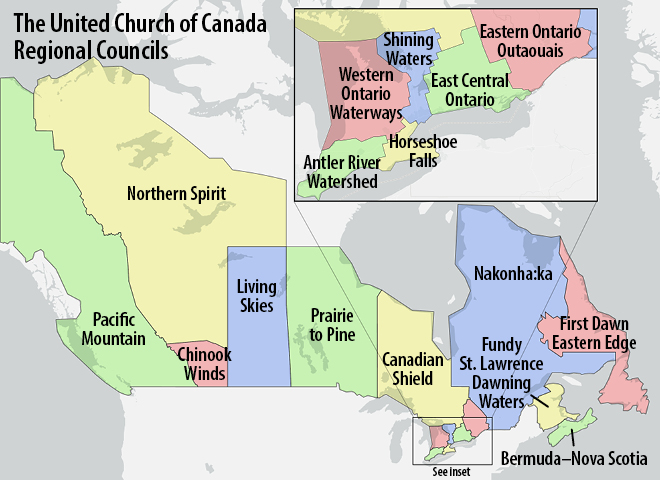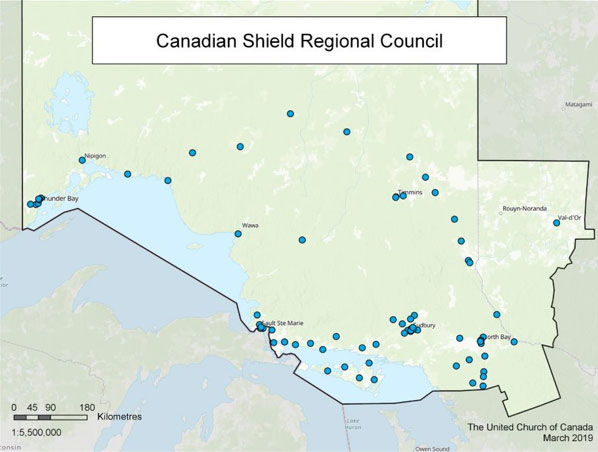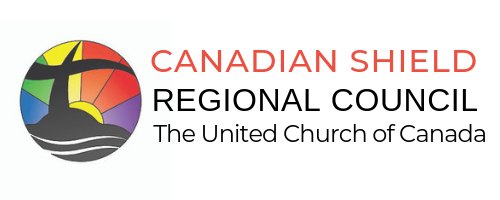
Canadian Shield Regional Council
Engaging With the Spirit to Inspire, Connect and Empower Communities of Faith
Governance
The CSRC’s governance structure consists of an Executive, a Pastoral Relations Commission, the Communities of Faith Commission and a Nominating Committee. There are Resource Teams for Living Into Right Relations, Mission Support, Grant Review, Affirming Ministry, Youth and Young Adults.
CSRC Governance Document (Nov. 2021 Revision) – PDF – 30 pages

About Our Logo
Our logo is a graphic reflection on our theme for our inaugural meeting: “moving forward with the Spirit“. The cross is grounded on rock, capturing our geography, but also depicts movement and fluidity. Unlike a traditional angular cross, this one illustrates that the cross is reaching its arms outward and upward across the landscape. The white streams of water speak to the movement of creation in our waterways, but also the movement of God’s Spirit in life-giving and life-affirming gift of the water of life. As the sun rises, its rainbow light speaks of a world, a Church, a community of faithful who welcome the new day, the new light of new life, with inclusivity and appreciation for diversity. As we move into the new day of the Church, we are indeed moving forward with the Spirit.
Territorial Acknowledgment
There is a map and more information on the more than 40 treaty and land agreements in Ontario on the provincial government treaty website https://www.ontario.ca/page/map-ontario-treaties-and-reserves.
Frequently Asked Questions

What is a Regional Council?
As of January 1, 2019, The United Church of Canada adopted a three-council structure, consisting of communities of faith, regional councils and a denominational council. Canadian Shield Regional Council is one of 16 regional councils in The United Church of Canada, replacing former conferences and presbyteries. Learn more about The United Church of Canada on their website. A regional council is an administrative grouping of communities of faith in a local area. Laypeople and ministers meet to oversee the work of the church within each region. Laypeople and ministers meet to oversee the work of the church within each region. The regional council is responsible for appointing an executive to do the continuing work of the regional council between regular meetings. For a full description of the polity of regional councils see The United Church of Canada 2025 Manual [PDF – 201 pages] – See page 37 – IV Regional Councils

What are the boundaries of the Regional Council
The CSRC is composed of all ministry personnel within its geographic bounds; ministers of denominations within mutual recognition agreements while under appointment or call; and lay members elected by the Communities of Faith, respecting the balance of lay and ministry personnel where possible.
The CSRC consists of: All pastoral charges in the previous Manitou Conference; All pastoral charges in the previous Algoma Presbytery; All pastoral charges in the Eastern Time Zone portion of the previous Cambrian Presbytery, save Atikokan PC. For a total of 79 Pastoral Charges.
What are the responsibilities of a Regional Council with respect to candidates for ministry?
The Regional Council is responsible for: celebrating the approval of applicants for candidacy; ordaining and commissioning members of the order of ministry; recognizing designated lay ministers; and celebrating admissions and re-admissions. (The Manual C.2.7)
For more information about the process for entering ministry in The United Church of Canada please see their Candidacy Pathway page. To find out more about our Pastoral Relations please see our webpage section.
What is the membership of the Regional Council?
The Regional Council consists of members of the order of ministry, other ministry personnel, lay members of the United Church, and leaders of associate member ministries, all as set out in The Manual 2025 C.1.1 to C.1.3. The president and secretary of the regional United Church Women or their designates will be members of the Regional Council. The Region has power / authority to add members to the Regional Council.
What is the basis of quorum for the Regional Council?
The Regional Council may meet only if a minimum number of members is present. (The Manual 2025, C.4.3) For meetings of the Regional Council:
- if there are fewer than 60 members, at least 1/3 of them must be present;
- if there are 60 or more members, at least 20 members must be present; and
- there must be at least one ministry personnel and one lay member who is not ministry personnel present
Corresponding members are not counted for this purpose.
Elected Lay Representatives
How are Lay Representatives Elected to the Regional Council?
Communities of faith that are congregations or pastoral charges continue to elect representatives to the regional council in the same way they elected representatives to the presbytery prior to January 1, 2019. They may also change the way in which they elect representatives within denominational policies, with the agreement of the regional council, and by including it in the covenant between the community of faith and regional council.
The lay members of the regional council are members of the United Church who are not ministry personnel and who are:
a) elected by communities of faith on the following basis:
- i) one representative from each community of faith with 100 or fewer members;
- ii) two representatives from each community of faith with 101 to 200 members;
- iii) three representatives from each community of faith with 201 to 300 members;
- iv) four representatives from each community of faith with more than 300 resident members; and
b) additional lay members as determined by the regional council if necessary to respect a balance of ministry personnel and lay members who are not ministry personnel in the membership of the regional council.
What are the responsibilities of Lay Representatives to the Regional Council?
- Lay Representatives have the following responsibilities to their community of faith:
- You are the primary communication hub between the Regional Council and your community of faith.
- Share emails you receive about the work of Regional Council widely in your congregation.
- Share written reports about Regional Council work with the governing body of your community of faith on a regular basis, even if you are not a members of the governing body.
- Write an annual report for the Annual Report of your community of faith.
- Help people in your community of faith know who they should talk to in the regional council about their questions/concerns/need for information.
Read the full Elected Regional Lay Representative Job Description.
For more information on Elected Regional Lay Representatives, please see our Elected Regional Lay Reps page.
